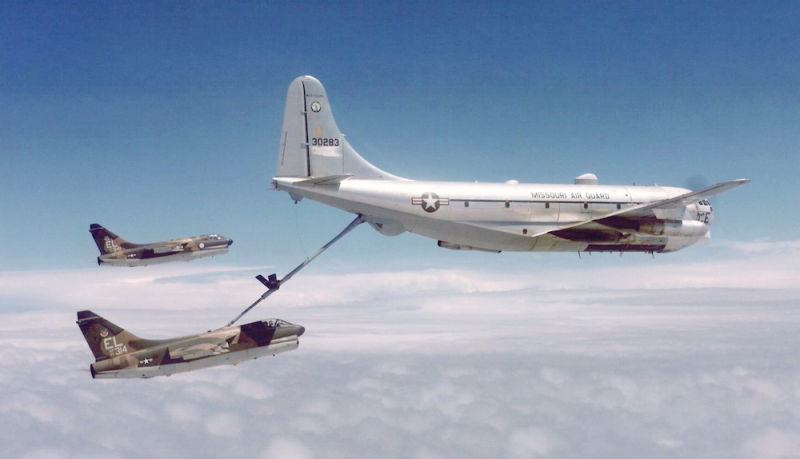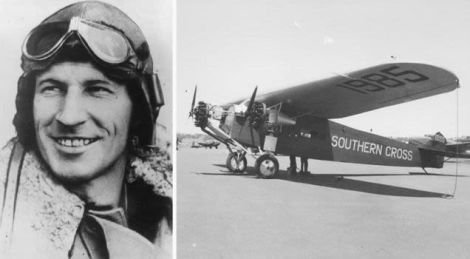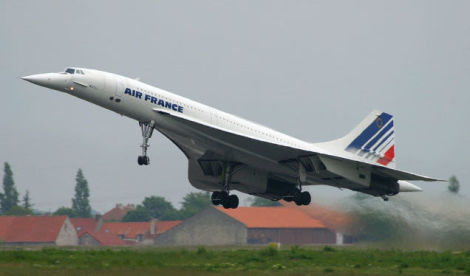Welcome to This Date in Aviation History, getting of you caught up on milestones, important historical events and people in aviation from November 7 through November 9.
November 9, 1946 – The first flight of the Lockheed Constitution. Throughout aviation history, there have been numerous double-deck aircraft. Some were just very large aircraft with two decks, but others were so-called “double bubble” aircraft. Since a pressurized aircraft is essentially an aluminum tube, a double bubble aircraft stacks one tube atop another to create more space for passengers or cargo. While some aircraft were modified as double-deckers from existing aircraft, the Lockheed Constitution was designed from the ground up to be a double bubble double-decker.
Development of the R6V began in 1942 with a joint study by the US Navy, Pan Am, and Lockheed to develop a large transport aircraft to supplement the Navy’s aging fleet of flying boats. Pan Am signed to the project on in the hopes that any aircraft coming out of the partnership might also have commercial applications. Design specifications stated that the fully pressurized aircraft must be capable of carrying 17,500 pounds of payload at an altitude of 25,000 feet for 5,000 miles. When it was completed, the Constitution was the largest fixed wing aircraft ever flown by the US Navy, but only two were ever built.

Ship No. 1 was completed in 1946 and took its maiden flight on November 9 of that year. Flight testing showed the engines to be significantly underpowered, so they were replaced by more powerful Pratt & Whitney R-4360 Wasp Major engines with water injection that offered 3,500 horsepower each. Rockets could also be mounted under the wings to assist in takeoffs with heavier payloads. Ship No. 2 took its maiden flight on June 9, 1948 and had an upper deck sumptuously fitted out for 92 passengers and 12 crew. The lower deck was fitted for cargo, but could also be configured to carry 76 passengers in addition to those on the upper deck. On February 3, 1949, Ship No. 2 flew 74 members of the press from Moffett Field in California to Washington National Airport, setting a record for the most passengers transported on a nonstop transcontinental flight.

In the end, though, the Constitution couldn’t live up to its billing. It remained underpowered, even with its engine upgrade, and problems with engine overheating led to a reduced operational range. In 1949, the Navy decided that the aircraft were just too expensive to operate and offered to lease them to the airlines. But there were no takers. Both aircraft were eventually sold for $97,785 in a deal that included 13 engines, which was quite bargain considering that the contract to build the two aircraft cost the US government $27 million. After the sale, both Constitutions suffered ignominious fates. Ship No. 1 was taken to Las Vegas where it was used as a giant billboard for Alamo Airways. It ended up being scrapped by Howard Hughes when he bought the property. Ship No. 2 was taken to Opa-Locka Airport in Florida and stored at an airfield. It was eventually moved off the airport to a new storage site, and there were plans to use it as a restaurant and museum. But those plans fell through, and the aircraft was finally scrapped in 1978.

November 9, 1944 – The first flight of the Boeing C-97 Stratofreighter. It is probably safe to say that the Boeing B-29 Superfortress was one of the greatest airplanes to come out of WWII. Not only was the B-29 an exceptional bomber, it proved to be such a versatile aircraft that its descendants continued serving long after the war was over, and they did so in many different guises. After its initial use as a long-range bomber, the B-29 was pressed into service as the KB-29 aerial tanker, which helped the US Air Force develop procedures for reliably refueling aircraft in the air. Later, the B-29 was developed into the B-50, the last piston-engined bomber produced for the US Air Force, as well as the KB-50 aerial tanker variant. Both were eventually replaced by newer jet-powered designs, but a more radical descendant of the venerable B-29 served for more than 30 years, and served into the 1970s.

The B-29 was originally designed with the single purpose of carrying a large load of bombs a great distance. But with the end of WWII, what the Air Force really needed was an aircraft that could carry tons of cargo or large numbers of passengers or troops. Starting with the proven B-29 Superfortress, Boeing retained the engines, wings, tail, and half the fuselage, but then added a second, larger tube on top, giving the C-97 a double bubble structure that significantly increased its cargo-carrying capacity. After the construction of the first 10 Stratofreighters, the engines were upgraded to the same 3,500 horsepower Pratt & Whitney R-4360 Wasp Major engines used on the B-50. The taller vertical stabilizer was also borrowed from the B-50 to compensate for the larger fuselage. Clamshell doors opened under the tail for loading, and a ramp allowed vehicles or other equipment to be driven directly into the cargo hold. However, these doors could not be opened in flight, so the C-97 was not capable of performing parachute drops of troops.

The C-97 was introduced in 1947, and one C-97 took part in the Berlin Airlift, but a landing accident grounded it until after the crisis ended. The Stratofreighter went on to serve in both the Korean War and the Vietnam War, and was also converted into an early airborne command post for the Strategic Air Command. And, like its B-29 predecessor, the C-97 was developed into the KC-97 aerial tanker, and the later the KC-97L was made faster by the addition of a General Electric J47 turbojet engine under each wing to help it keep pace with faster jet fighters. Later, in yet further testament to Boeing’s flexible design, the C-97 was developed into the 377 Stratocruiser, a double-decker, pressurized airliner that could accommodate up to 114 passengers on its two decks. But even that wasn’t the end of the lineage that started with the B-29, as the 377 was also developed into the Aero Spacelines Guppy series of super-size cargo aircraft. A total of 888 C-97s were built, with the bulk of them serving in the aerial refueling role. After finishing its service with the National Guard, the C-97 was finally retired in 1978.
Short Takeoff
November 7, 2001 – The Concorde resumes passenger flights. On July 25, 2000, Air France Flight 4590 (F-BTSC) crashed shortly after takeoff from Paris-Charles de Gaulle Airport. The official cause of the crash was cited as debris on the runway that damaged a tire and lead to a fuel leak and catastrophic fire. Though it was the only crash in the history of Concorde operations, all Concordes were grounded during the investigation, and remaining aircraft were updated with Kevlar-lined fuel tanks and burst-resistant tires before retuning to service. Despite its return to passenger service, the Concorde could not overcome a downturn in air travel following the Flight 4590 crash and the September 11 terrorist attacks. High maintenance and fuel costs added to the Concorde’s woes, and all Concordes were retired in 2003.

November 8, 1935 – The death of Charles Kingsford Smith. Kingsford Smith, known by his nickname “Smithy,” served as a motorcycle dispatch rider during the Gallipoli Campaign in WWI before joining the Royal Flying Corps in 1917. Following the war, he worked as a barnstormer in the US and flew airmail in Australia, and initially became famous for completing the first crossing of the Pacific Ocean in 1928, flying from California to Australia with Charles Ulm in a Fokker F.VII/3m named Southern Cross. Kingsford Smith followed that with the first flight across Australia and the first flight across the Tasman Sea from Australia to New Zealand in 1928, and a westward crossing of the Atlantic Ocean from Ireland to Newfoundland in 1930. He also made the first eastward crossing of the Pacific in 1934 in a Lockheed Altair named Lady Southern Cross. During an attempt to break the record for flying from England to Australia, Kingsford Smith and co-pilot John Pethybridge, flying the Lady Southern Cross, disappeared over the Andaman Sea near Burma, and their bodies were never found.

November 9, 1979 – The death of Louise Thaden, a pioneering aviatrix and the first woman to win the prestigious coast-to-coast Bendix Trophy Race. Thaden (née McPhetridge) was born on November 12, 1905 in Bentonville, Arkansas and entered the world of flying as a sales representative for the Travel Air Corporation owned by Walter Beech. As part of her pay, she received free flying lessons, and became the first woman to earn a pilot license in Ohio and later the fourth woman to earn a rating as a transport pilot. Thaden shocked the world when she and her copilot Blanche Noyes won the Bendix transcontinental race, setting a new world record time of 14 hours 55 minutes while flying a Beech C17R Staggerwing. But that wasn’t the first of Thaden’s accomplishments. She set a altitude record of 20,260 feet for woman pilots in 1928, an endurance record of over 22 hours in 1929, teamed up with another aviatrix, Frances Marsalis, to set a record time of 196 hours in the air, and was a founding member of the Ninety-Nines organization for woman pilots. Though she retired from racing in 1938 and world for the Bureau of Air Commerce, and flew with the Civil Air Patrol during WWII. Thaden died in 1979.

November 9, 1967 – The launch of Apollo 4, the first launch after the Apollo 1 disaster that killed three astronauts. Apollo 4 was the critical first “all up” test for NASA, which meant that all the rocket stages and the spacecraft were operational at launch, though the flight was unmanned. Apollo 4 was also the first launch of the Saturn V launch vehicle, the tallest, heaviest and most powerful rocket ever used operationally. Apollo 4 was launched from the Kennedy Space Center Launch Complex 39, which had been specifically built for the huge Saturn V, and was the first mission to test all elements of the multi-stage rocket. The flight lasted nine hours before splashing down in the Pacific Ocean.
Connecting Flights
If you enjoy these Aviation History posts, please let me know in the comments. And if you missed any of the past articles, you can find them all at Planelopnik History. You can also find more stories about aviation, aviators and airplane oddities at Wingspan.

